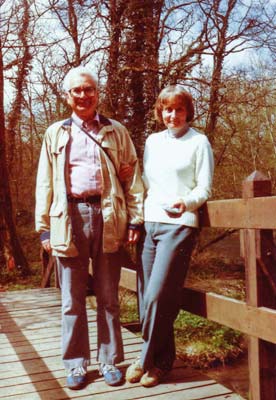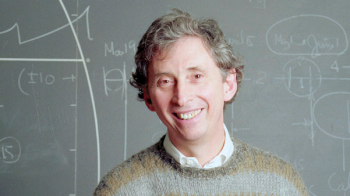André Martin reminisces on the occasion of Gell-Mann’s 80th birthday.

Image credit: A Martin.
Murray Gell-Mann and I were born a few days apart in September 1929. Being born on almost the same date as a genius does not help much, except for the fact that by having the same age there was a non-zero probability that we would meet. And indeed this is what happened; furthermore, we and our families became friends. Because I was unable to attend the meetings in honour of Murray, I am making this testimony on the occasion of his 80th birthday.
Murray’s family was much affected by the crash of October 1929. His father had to change jobs completely. If this had not happened, it is possible that Murray might have become a successful businessman instead of a brilliant physicist. Everybody knows that Murray is immensely cultured and has multiple interests. I can quote a few at random: penguins, other birds (tichodromes for instance), Swahili, Creole, Franco-Provençal (and more generally the history of languages), pre-Columbian art and American-Indian art, gastronomy (including French wines and medieval food), the history of religions, climatic change and its consequences, energy resources, protection of the environment, complexity, cosmology and the quantum theory of measurement. However, it is in the field of theoretical particle physics that he made his most creative and important contributions. For these, I personally consider him to be the best particle-physics theoretician alive today.
Bright beginnings
I met Murray for the first time at Les Houches in 1952, one year after the foundation of the school by Cecile Morette-DeWitt. It was immediately obvious that he was extremely bright. Then he was invited by Maurice Levy to the Ecole Normale and gave some lectures at the Institut Henri Poincaré. He gave these in French, which had an amusing consequence as a result of a practical joke by Maurice. For months, as they worked together, speaking French, whenever Murray had said something like “ces deux termes s’annulent” (these two terms cancel) Maurice repeated it, substituting “se chancellent” for “s’annulent.” Now Murray knew that “chanceler” means to wobble and not to cancel, but he finally supposed that in English-influenced French scientific jargon, “chanceler” could mean “to cancel.” Otherwise, why would Maurice keep using that word? When Murray actually employed the word in one of his lectures, Maurice went into paroxysms of laughter.
In 1955 I attended my first physics conference, in Pisa. After a breakfast with Erwin Schroedinger, I took the tram and met Murray. In the afternoon, at the University of Pisa, he made the first public presentation of the strangeness scheme. The auditorium was packed. I was completely bewildered by this extraordinary achievement, with its incredible predictive power (which was very soon checked) including the KK system. I had already left Ecole Normale-Orsay for CERN when he and Maurice wrote their famous paper featuring for the first time what was later called the “Cabbibo angle”.
I then had the luck to be sent to the La Jolla conference in 1961. There I met Nick Khuri for the first time, who became a close friend, and I heard Murray presenting “the Eightfold Way” (i.e. the SU(3) octet model). Also attending were Marcel Froissart, who derived the “Froissart Bound”, and Geoff Chew, who presented his version of the S-matrix programme. Both were most inspiring for my future work. What I did not realize at the time was that the Chew programme had been largely anticipated by Murray, who first was involved in the use of dispersion relations and then noticed, in 1956, that the combination of analyticity, unitarity and crossing symmetry could lead to field theory on the mass shell, with some interesting consequences (as exemplified by Froissart’s work and by my later work on the subject).
In 1962, during the Geneva “Rochester” conference, I was again present when Murray, after a review of hadron spectroscopy by George Snow, stood up and pointed out that the sequence of particles Δ, Σ*, Ξ* could be completed by a particle that he called Ω– to form a decuplet in the SU(3) scheme. He predicted its mode of production, its decay, which was to be weak, and its mass. This was followed by a period of deep scepticism among theoreticians, including some of the best. However, at the end of 1963, while I was in Princeton, Nick Samios and his group at Brookhaven announced that the Ω– had been discovered, with exactly the correct mass within a few mega-electron-volts. Frank Yang, one of the sceptics, called it “the most important experiment in particle physics in recent years”. I missed the invention of the quarks, being in Princeton, far from Caltech, where Murray was, and from CERN where George Zweig was visiting. I met Bob Serber but I was completely unaware of his catalytic role in that discovery.
Close friends
My next important meeting with Murray was in Yerevan in Armenia in 1965, where Soviet physicists had invited a group of some eight western physicists. This time Murray came with his whole family: his wife, Margaret – a British archaeology student whom he met in Princeton – and his children, Lisa and Nick. During the following summer, which the Gell-Manns spent in Geneva, our families met several times. I remember once when my children, seeing a portrait of Lisa by the famous Armenian painter H Galentz, said: “This is a green Lisa.” The Gell-Manns spent another year at CERN before Harold Fritzsch, Gell-Mann, and Heinrich Leutwyler wrote the “Credo” of QCD.
Margaret and Murray came to Geneva again for the academic year 1979/80. They were living in an apartment in the same group of buildings as us. Schu, my wife, then became a close friend of Margaret, who was a typically British girl: very reserved, very intelligent and possessing a good sense of humour. An example of how she was very modest is that, while we knew that she had been digging at Mycenae for an archaeologist named Alan Wace, we found out only long after her death that she had played a personal role in destroying a theory of Sir Arthur Evans, who claimed wrongly that the Cretans had dominated the Mycenaeans during a certain part of the late-Minoan period – while the reverse was true. In fact, she was the first to discover a Linear B tablet at Mycenae. Although Carl Blegen had found Linear B tablets at Pylos long before, finding them at Mycenae as well was important additional evidence once Michael Ventris had proved that the language of Linear B was an early form of Greek, and that Margaret’s boss was right. He had suffered terribly from his refusal to agree with Evans.
An extraordinary friendship grew up between Margaret and Schu. When the Gell-Manns left Geneva for Pasadena, Margaret knew that there was something wrong with her health. Back in the US she discovered that she had cancer. I do not know the number of transatlantic trips that we made – sometimes both of us, sometimes Schu alone – to help Margaret. This included stays in Aspen during the summers of 1980 and 1981. In between, Schu and Margaret had an extensive correspondence. Schu decided to initiate Margaret into French poetry. In particular, she sent Margaret poems by Jacques Prévert and Paul Eluard. On Margaret’s grave, in Aspen, Murray put the inscription: “Mais ou en est ce léger sourire” (Eluard, about Nuesch, his late wife). After Margaret’s death, we all kept in touch because Murray has one remarkable quality: faithfulness in friendship.
• I am grateful to my wife, Schu, and to Murray for suggestions and corrections.








